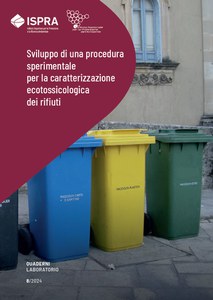Experimental procedure for ecotoxicological characterization of waste
Council Regulation (EU) 2017/997 establishes the methods for hazardous property HP 14 ‘Ecotoxic. The Regulation establishes the criteria for attributing the "ecotoxic" hazard property to waste through the application of the "conventional method", according to which the ecotoxicity is established from a chemical point of view, through the sum of the concentrations of substances classified as "ecotoxic", according to Regulation 2008/1272/EC (CLP regulation).
The conventional method is applied by referring to substances dangerous for the aquatic environment in the CLP Regulation, while the determination of the hazardous characteristics of the waste is carried out on the basis of the criteria and limit values set out in Annex III to Directive 2008/98/EC. The hazardous property HP 14 can also be determined by carrying out experimental tests according to the methods of Regulation 2008/440/EC, or by “performing a test in accordance with Regulation (EC) No 440/2008 or other internationally recognised test methods and guidelines" (point eighth of the Council Regulation (EU) 2017/997). In this case, the results of the ecotoxicological tests prevail over the evaluation carried out with the conventional method. However, the European Commission leaves to the “Member States to decide, on a case-by-case basis, on the acceptability and interpretation of results resulting from the ecotoxicological characterisation of waste using biotests including, where appropriate, considerations about bioavailability and bioaccessibility”. For the purposes of attributing the HP14 hazard characteristic, the criteria and procedures established for substances and mixtures pursuant to the CLP Regulation are not directly applicable to waste. The results of an extensive chemical-ecotoxicological analytical activity on 5 types of waste (car-fluff, waste derived from MBT, MSWIBA, fly-ash and slag from industrial WT) were used to develop an experimental procedure, based on a Weight Of Evidence (WOE) approach. This procedure, going beyond the classic chemical and/or ecotoxicological threshold approach, introduces a weighted integration method which, through synthetic chemical and ecotoxicological indexes, allows the overall environmental danger of a waste to be assessed in a more realistic approach.
Publication available only on-line
Download the publication (pdf - 5 mb)

